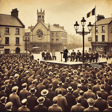
The Norrmalmstorg Robbery
Episode fourteen of the new series of Pieces of History steps into the heart of 1970s Stockholm, where a botched bank heist gave rise to one of psychology’s most confounding concepts: Stockholm Syndrome.
In this episode, we unravel the tense six-day standoff at Kreditbanken in Norrmalmstorg Square - a robbery that turned into a media circus, a national spectacle, and a defining moment in the study of trauma and empathy. As police surrounded the building, something strange was happening inside: hostages began identifying with their captors, defending them, even fearing the authorities more than the gunmen.
Who were the players in this gripping drama? What psychological mechanisms were at work behind the vault doors? And how did a single phrase - “Stockholm Syndrome” - come to define hostage dynamics for generations?
This is more than a story of crime and crisis. It's a window into the human psyche, a moment when fear, trust, and identity collided - and changed how we understand captivity, survival, and loyalty.
Email: piecesofhistorypod@outlook.com
Facebook: Pieces of History podcast
Instagram: @pieceofhistorypod



















